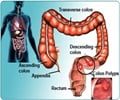The use of antibiotics during mid-life has been found to be associated with increased risk of pre-cancerous polyps.
- Antibiotics have been in use for treatment against harmful infectious bacteria; however, apart from killing the infectious agent they also kill the normal microflora of the body.
- 69% higher risk of adenomas was identified among women who took antibiotics for longer than two months during their 40s and 50s when compared with women who were not on antibiotics.
- 73% increased risk for adenomas was identified among women who were on antibiotics for longer than 15 days, at least twice during mid-life
The current study was based on the information available in the Nurses’ Health Study which includes monitoring 121,700 US nurses aged between 30 and 55 at the time of the start of the study in 1976. The nurses were made to fill in the questionnaire, which included questions on lifestyle factors, demographics, disease, medical history, every two years. The dietary habits of the nurses were recorded every four years.
Inclusion Criteria:
The study included details of 16,642 women who were able to fill in details about the history of their antibiotic use and who were aged 60 and above in 2004. Women between 20 and 60 years of age were included If they had had a bowel investigation at some point in their life.
The findings of the study were
- 1195 adenomas were identified newly in this group
- The use of antibiotics within the recent 4 years did not affect the risk for adenomas
- There was increased risk for adenomas when there was long-term use of antibiotics.
- There was 36% increased risk for adenomas when antibiotics were taken for two months or more when the study participants were in their 20s or 30s when compared to women who hadn’t.
- The risk of adenomas was high, irrespective of whether the adenoma had a high or low risk of developing into bowel cancer.
- There was a strong association with growth present in the proximal region (which is the cecum or the pouch like region present in between the small and the large intestine, splenic flexure, which refers to the bend that occurs between transverse colon and the descending colon and the hepatic flexure) rather than in the colon’s distal region, which is the sigmoid colon or the descending colon.
- There was 69% higher risk of adenomas among women who were on antibiotics for two months or longer when they were in their 40s and 50s, compared to women who were not on antibiotics during that stage.
- There was 73%
increased risk for adenomas among women who took antibiotics for more than 15
days between the ages of
- 20 and 39
- 40 and 59
The scientists caution that this study was observational and that some adenomas could have been present even before antibiotic use. However, the existence of the association between antibiotics and the risk of polyps is plausible, according to the research team.
Antibiotics kill micro-organisms, irrespective of whether they are pathogenic or part of the microbiome of the body. The use of antibiotics for a prolonged period of time, drastically lowers the diversity as well as the number of bacteria. The reduction in the number of bacteria which are a part of the microbiome could make way for the colonization of harmful bacteria. This could contribute to the increased risk for bowel cancer.
A similar study conducted to identify the risk for developing lung, breast and colon cancer and the use of antibiotics was carried out as a large observational study, published in the International Journal of Cancer. The study found that there was a risk for less common forms of cancer, including bladder, kidney, male genitals, pancreas, kidney, thyroid cancers, leukemia and myeloma, with a 1.5 times higher risk among people who were on six or more antibiotic prescriptions when compared with people who did not have antibiotics.
The findings of the study suggest that there is a need to restrict the use of antibiotics as well as to lower the risk for inflammation that could lead to potentially dangerous pre-cancerous lesions.
What is a Colon Polyp?
A small growth develops along the inner lining of the large intestine which has an increased risk of developing into cancer. These small growths or polyps may be present all over the colon and could vary in size, from several centimeters to a few millimeters.
These polyps could have a raised appearance or they could be flat. The raised polyps have a stalk and resemble the appearance of a cauliflower or a mushroom.
Reference:
- Yin Cao et.al., 'Long-term use of antibiotics and risk of colorectal adenoma' BMJ Journal, (2017); Colon Polyps - (http://patients.gi.org/topics/colon-polyps/)
Source-Medindia















